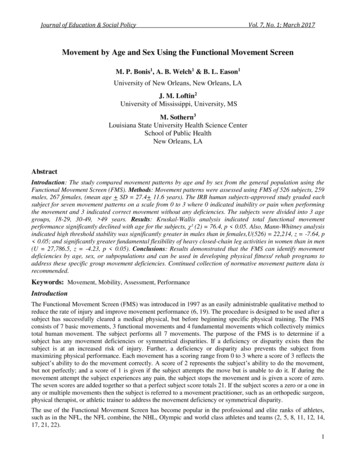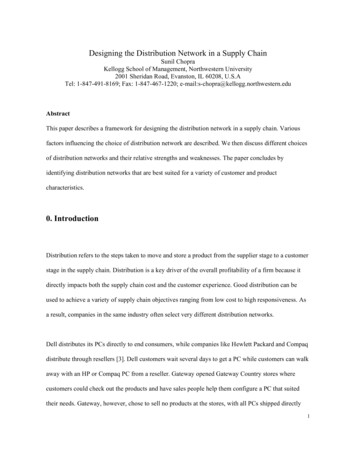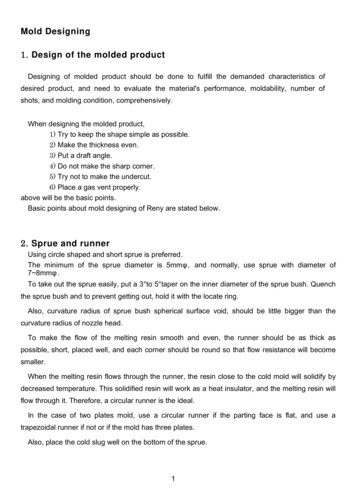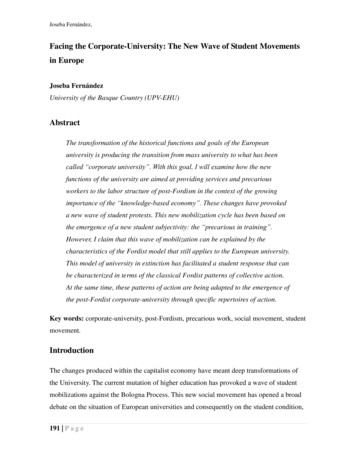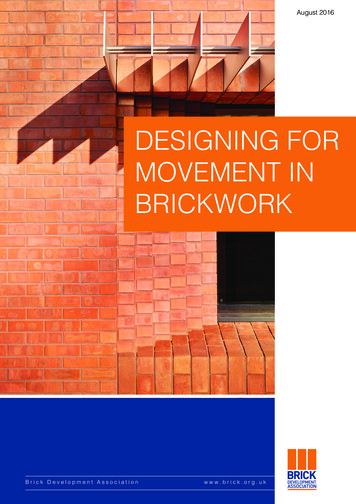
Transcription
August 2016DESIGNING FORMOVEMENT INBRICKWORKBrick Development Associationwww.brick.org.uk
2BDA GUIDE - DESIGNING FOR MOVEMENT IN BRICKWORKContentsINTRODUCTIONVERTICAL MOVEMENTJOINTS SPACINGMOVEMENT JOINT POSITIONSAND BUILDING DETAILSPage34-56-10HORIZONTAL JOINTS TO ACCOMODATEVERTICAL MOVEMENT11MATERIALS FOR MOVEMENT JOINTS11CLAY BRICKWORK - SIMPLE GUIDELINES12-13
3BDA GUIDE - DESIGNING FOR MOVEMENT IN BRICKWORKINTRODUCTIONAll building materials are subject to movement. This movement is due to a number of reasons including:llllThermal expansion / contraction due to temperature changesMoisture movementCreep and structural loadingThe effects of chemical changes such as sulphate attackIt is the first two of these which are particularly influential on masonry movement. Clay brickwork willgenerally be subjected to long term expansion while concrete masonry, aggregate blocks, aircrete blockswill be prone to shrinkage.The expansion and contraction of masonry needs to be accommodated and controlled by the inclusionof both vertical and horizontal joints within the building. If such movement is not allowed for there will be abuild-up of internal stresses and a risk of cracking which is unsightly and costly to repair. The frequency,location and the width of the joints should be sufficient to accommodate both reversible and irreversiblemovements.This document provides empirical recommendations for the specification and location of movement joints inclay brickwork and it is applicable to the majority of construction situations.References:l PD6697 Recommendations for the design of masonry structuresl EC6 Eurocode 6 Design of Masonry Structuresl BS 8000-3 Workmanship on Building SitesJafar Gallery and Jafar Hall, Eton CollegeBrick Development Associationwww.brick.org.uk
4BDA GUIDE - DESIGNING FOR MOVEMENT IN BRICKWORKVERTICAL MOVEMENT JOINT SPACINGWhen designing for brickwork movement consideration must be given to the geometry of the building and itsorientation. South, South West and South East facing elevations will be susceptible to more movement and anincrease in joint frequency should be considered, particularly where darker coloured bricks are being used.Unrestrained or lightly restrained unreinforced walls expand approximately 1mm/m during the life of a buildingdue to combined thermal and moisture movement changes. Not all clay types expand at the same rate and insome cases an allowance of greater than 1mm/m may be necessary. It is advisable to check this informationwith the brick manufacturer when specifying movement joints.As a general guide and to allow for the compressibility of the movement joint filler, the width of the joint inmillimetres should be about 30% more than the distance between joints in metres. For example, movementjoints at 12m centres should be 16mm wide.A vertical movement joint should be located at no greater than half the maximum spacing from a corner orreturn in a wall. Hence for joint spacing of 12m in a straight run of walling, a joint is required to be no more than6m from the corner.10 -12m joint spacingFig. 1 Typical verticalmovement joint spacingJoint spacing at external returns should be based on being continuous around the corner.Fig. 2 Typicalvertical movementjoint spacing at anexternal return12mm126mmax6mxmaMJMJMJMJ12m (maximum)Brick Development Associationwww.brick.org.uk
5BDA GUIDE - DESIGNING FOR MOVEMENT IN BRICKWORKVERTICAL MOVEMENT JOINT SPACINGIn freestanding walls, parapet walls, unrestrained or lightly restrained brickwork and non load-bearingcladding or spandrel brickwork panels brickwork movement joints should be provided at twice thefrequency recommended for full walls as described previously. For these walls the joint spacing should notexceed 6m.Note:- Some manufacturers recommend reduced joint spacing for copings and cappings.Fig. 3 Freestanding wall3m6m6mCopingMJGLMJFig. 4 Parapet wall12m6m6mCopingParapetSlip planetypical cavitytray positionMJMJBrick Development AssociationMJGLwww.brick.org.uk
6BDA GUIDE - DESIGNING FOR MOVEMENT IN BRICKWORKMOVEMENT JOINT POSITIONS ANDBUILDING DETAILSFeatures of the building which should be considered when determining joint positions in masonry are:1.2.3.4.5.Short returns in clay masonryChanges in height or external materialsWindow and door openingsLocation of wall ties with respect to movement jointsBed joint reinforcement1. Short returns in clay masonryIf a return in the length of brickwork is less than 675mm, movement joints should be included to avoid therisk of cracking. This can be achieved by the introduction of a vertical, compressible joint or a “slide-by”detail (see below).Fig. 5 Mechanical couple in short return of clay masonryTendency to crack inthese positions675mm7Figs. 6 and 7 Preferable positions for movement jointsCompressible joint3Brick Development Association“Slide by” joint3www.brick.org.uk
7BDA GUIDE - DESIGNING FOR MOVEMENT IN BRICKWORKMOVEMENT JOINT POSITIONS ANDBUILDING DETAILSReturns of 1m or more should be flexible enough to allow brickwork to move without cracking. (See below).Fig. 8 Long return - more than 1mWall distortsbut less likelyto crackMore than 1mFig. 9 Alternative arrangement using compression joints at some distance from the cornerMJ1-2mLong length1-2mMJLong lengthBrick Development Associationwww.brick.org.uk
8BDA GUIDE - DESIGNING FOR MOVEMENT IN BRICKWORKMOVEMENT JOINT POSITIONS ANDBUILDING DETAILS2. Changes in height or external materialsIt is advisable to consider locating vertical expansion joints where there is a significant change in heightwithin the building elevation or wherever there is a change in material such as rendered blockwork or stone.This can be achieved by the introduction of a vertical, compressible joint or a “slide-by” detail (see below).Fig. 10 Movement joint position at a change in heightLoadLoadMJFoundationCompressiontype joint3. Window and door openingsFig. 11 Cracking due to differential horizontal traintBrick Development Associationwww.brick.org.uk
9BDA GUIDE - DESIGNING FOR MOVEMENT IN BRICKWORKMOVEMENT JOINT POSITIONS ANDBUILDING DETAILS4. Location of wall ties adjacent to movement jointsFig. 12 Typical movement jointCavity ties225mm max225mm maxFig. 13 Movement joint with sleeve debonding tieSleeved tieBrick Development Associationwww.brick.org.uk
10BDA GUIDE - DESIGNING FOR MOVEMENT IN BRICKWORKMOVEMENT JOINT POSITIONS ANDBUILDING DETAILS5. Bed joint reinforcementBed joint reinforcement may be used to extend the centres of vertical movement joints and to minimise therisk of cracking. Areas above doors and above or below windows may benefit from the inclusion of bed jointreinforcement to distribute tensile stresses and avoid localised cracking. Proprietary bed joint reinforcementswith parallel bars of at least 3mm diameter can be used to increase joint spacing. Light “chicken wire”meshes can be used for crack control only.Fig. 1412m Brickwork, like concrete, is good in compressionbut poor in tension and the addition ofreinforcement to the mortar bed joints will:l Give more freedom in spacing of movement jointsl Reduce cracking due to the following causes:- Movement due to fluctuating temperatures- Flexural or tensile stresses resultingfrom loadingFig. 15- Stress concentrations around openings(windows and doors)- Differential movement between bondedmaterials- Differential settlement- Irregular elevations- Changes in wall thicknessFig. 16Reinforcement is supplied in various widths andshapes to suit the application, but for externalwalling suitable grades of austenitic stainless steelshould always be specified.Design guides, and technical and structural adviceare available from manufacturers and suppliers,together with guidance on correct application andinstallation of the material.Brick Development AssociationFig. 17www.brick.org.uk
11BDA GUIDE - DESIGNING FOR MOVEMENT IN BRICKWORKHORIZONTAL JOINTS TO ACCOMODATEVERTICAL MOVEMENTPresent evidence suggests that vertical movement of unrestrained walls is of the same order as horizontalmovement.In order to avoid the detrimental effects of differential vertical movement between the inner and outerleaves of a wall a horizontal movement joint should be provided at no more than every third storey or 9m,whichever is the less. For buildings not exceeding 4 storeys or 12m height, whichever is the less, the outerleaf may be uninterrupted for its full height.Fig. 18Fig. 19RoofMovementThermal insulation9m maximumSecond floorDetail‘x’Continuous angleCavity trayWeepholes ata maximum of1m intervalshorizontallyPistol brick toreduce jointthickness on faceFirst floorSealantGround floorCompressiblejoint fillerDetail ‘x’: An example of a support system showing provision for movementMATERIALS FOR MOVEMENT JOINTSThe material for filling movement joints to accommodate expansion should be easily compressible toapproximately 50% of its original thickness. Flexible cellular polyurethane, cellular polyethylene or foamrubbers are satisfactory materials.Movement joints should be sealed with a polysulfide or low modulus silicon which has sufficient flexibility toaccommodate movement and be resistant to water penetration.Brick Development Associationwww.brick.org.uk
12BDA GUIDE - DESIGNING FOR MOVEMENT IN BRICKWORKCLAY BRICKWORK - SIMPLE GUIDELINESFOR SPECIFICATION OF MOVEMENTJOINTS1. In general, experience suggests that movement joints in clay brickwork should be spaced atapproximately 10 - 12 metres. PD 6697 states that in no case should joints exceed 15 metres and thespacing of the first joint from an internal or external angle should not exceed half of the general spacing.In long narrow runs of walling or panels, which have certain unrestrained edges, a spacing of half thegeneral recommendations should again be incorporated. Movement joints should be continuous for thefull height of brickwork.2. For unrestrained masonry such as parapets and free standing walls vertical joint spacing should bereduced to 5 - 6m centres. For copings and cappings which may be prone to greater movement furtherprovision of joints should be considered.3. With respect to horizontal expansion joints for vertical movement the outer leaf should be supported atintervals of not more than every third storey or every 9 metres whichever is less. However, forbuildings not exceeding four storeys or 12 metres in height, whichever is less, the outer leaf may beuninterrupted for its full height.4. Cracking due to movement can often be induced from the corner of openings, i.e. windows and doors,but the prediction of such cracking is extremely difficult with many parameters to consider, including theinteraction of various materials such as concrete and brickwork, and the structural behaviour of thebuilding. The use of bed joint reinforcement can provide some control over such cracking.5. Where the superstructure comprises a reinforced concrete frame, allowance must be made for the fullpotential differential movement between the frame and the clay masonry. This may necessitate provisionof horizontal expansion joints typically at every two storeys. If formed using a pistol brick (see page 11Fig. 19) the joint must be of sufficient width to allow for full differential movement.6. Brick cladding to timber framed buildings should be designed to prevent cracking as a result of stressesgenerated by vertical differential movement between the brickwork and the timber frame. Ref. PD6697cl. 6.2.6.8.7. When movement joints are positioned behind rain water pipes (rwp s) the fixings for the rwp s must allowfor sufficient movement of the brickwork.8. The location of vertical movement joints should take into consideration:llllshort returns and changes in direction on planchanges in height on elevationdifferent materials within the external leafsoutherly elevations which are more susceptible to temperature changesBrick Development Associationwww.brick.org.uk
13BDA GUIDE - DESIGNING FOR MOVEMENT IN BRICKWORK9. Wherever movement joints are positioned it is important that the Structural Engineers are aware of theirlocation to ensure that assumptions in brickwork design including the form of panel edge restraint, arefully considered.10. Joints should be weather sealed on the external face and be filled with an easily compressible material.Materials, which cannot be readily compressed by hand, will not normally allow free masonrymovement. PD6697 cl. 6.2.6.3.2 states that “the width of a joint in millimetres should be about 30%more than the distance between joints in metres”.The Whitworth GalleryBrick Development Associationwww.brick.org.uk
Telephone: 020 7323 7030Fax: 020 7580 3795Email: brick@brick.org.ukwww.brick.org.uktwitter: @BricksUKBrick Development AssociationThe Building Centre,26 Store Street,London,WC1E 7BTwww.brick.org.uk
BDA GUIDE - DESIGNING FOR MOVEMENT IN BRICKWORK Brick Development Association www.brick.org.uk MOVEMENT JOINT POSITIONS AND BUILDING DETAILS 6 Features of the building which should be con

